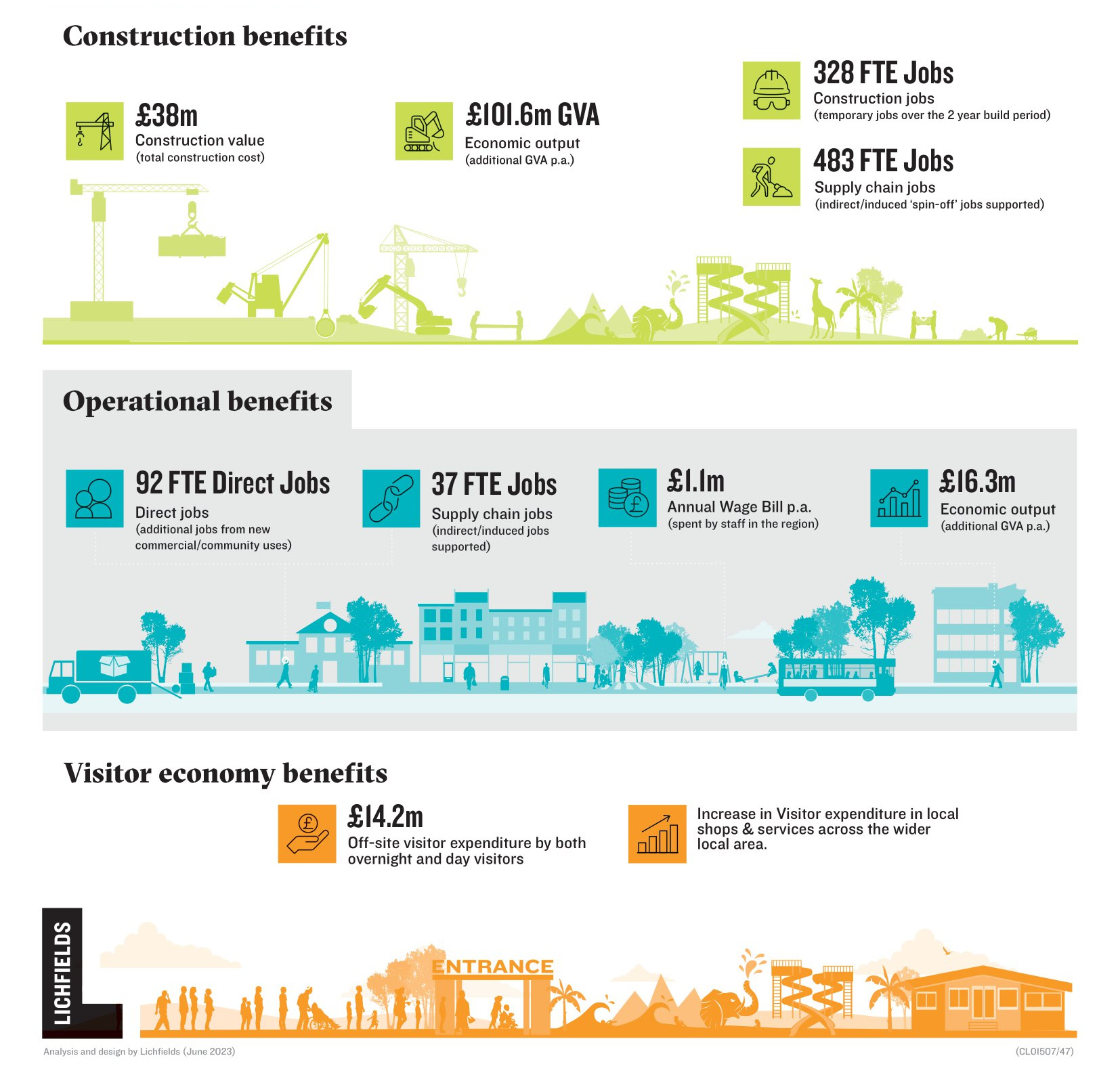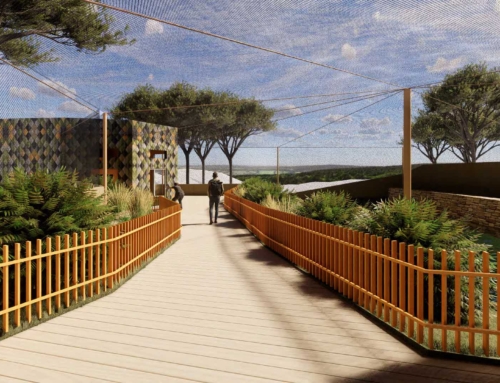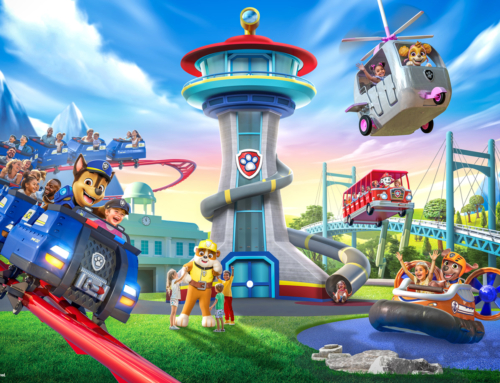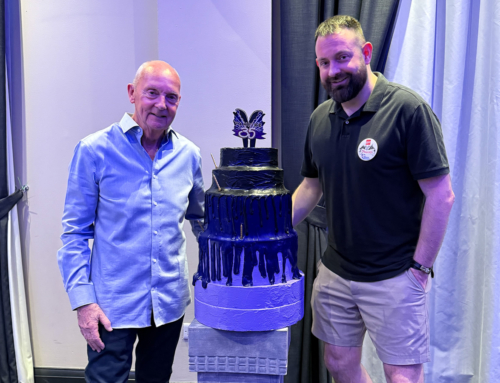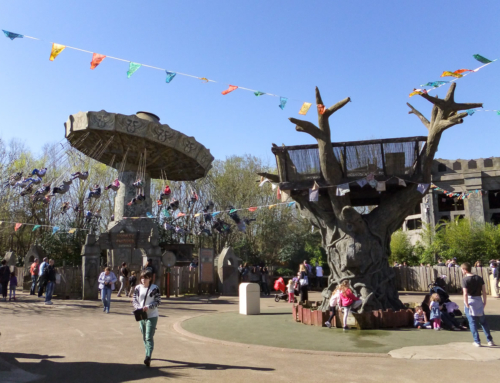Following a public consultation in late 2022, Chessington World of Adventures Resort have now submitted the full planning application for their proposed Waterpark Adventure development, codenamed Project Bruce.
Representing an investment of £38 million, the waterpark will be constructed as an extension to the northern wing of the Safari Hotel, with the vision of the project being to deliver a unique and immersive half-day family waterpark experience where guests encounter live creatures and animals during their visit. Specifically the development is noted as being aimed primarily at families with children under 12 years old, in line with the Resort’s wider target market, and it is highlighted that the waterpark has also been designed to be fully inclusive and accessible. The waterpark will operate within a maximum capacity of 1,200 guests, who will be sold a 4-hour time slot to experience the waterpark, with entry slots available every half hour. It will have peak season opening times of 10:00 to 20:00, in line with the theme park.
It is stated that the waterpark will be African-themed, adding to and reinforcing the current “wild” safari theme at the Resort. The planning application documents do refer to the development in numerous places as ‘Africa Falls’, offering a potential insight into its name. The project is said to be intended to open as “the UK’s first water splash adventure with real live animals”. The first element of this will be the views south-west over the existing Wanyama Reserve, where Giraffe, Antelope, Zebra, Ankole and Ostrich are free to roam, with large guest terraces, full-height glazing and outdoor water attractions set to make guests feel part of this setting. The project will then also incorporate a variety of fish tanks and reptile displays to create a unique waterpark experience. Concepts show the potential for animal experiences to be integrated in a variety of ways, such as by placing them above, below and all around guest areas, as well as through using digital technology including virtual reality.
The experience
It is outlined that the waterpark is conceptually split into two parts: the entrance sequence and the water adventure. The entrance sequence is considered to be ‘Base Camp’ and will start with guests accessing the attraction via a new dedicated waterpark entrance. This will be constructed to the right of the existing hotel lobby entrance as a small extension that is said to be themed as a cavern, featuring appropriately themed rockwork and transporting guests into the “magical world of the Africa Falls Adventure”. This deliberate contrast will help to differentiate the entrances and ensures clear wayfinding for guests. Theming the entrance in this way is also anticipated to provide an exciting introduction to the waterpark without relying heavily on signage. Inside will be found a retail outlet selling swimming essentials as well as merchandise and souvenirs, and it will be through this that hotel guests will be able to internally access the waterpark. Within the reception area will be multiple fish tanks, and electronic speed gates and digital ticketing will be used to create a smooth and efficient admissions process. There will be separate gates through which guests will exit the waterpark at the end of their visit, to aid with inward and outward guest flow.
Guests will then be directed through to the gender neutral Changing Village, which is said to play an important part in transporting visitors into the Africa Falls Adventure. This will offer various sizes of private cubicles ranging from single occupancy to changing rooms capable of accommodating large families. A number of cubicles will be equipped with baby seats, others with grab rails and accessible benches. Accessible toilets and shower facilities will also be available close to the entrance. After changing, guests will make their way through into the locker area, where a proportion of the lockers will be wheelchair accessible. A dedicated buggy store room will also be available. From there guests will be able to progress into the main pool hall, past the pre-shower area. There will also be full body dryers and a vanity area for use on the way out.
From the Changing Village, guests will enter the main pool hall of the waterpark on the ground level. Upon entry, guests’ focus will initially be shifted towards the full height glazed windows that provide views across Wanyama Reserve. These will be positioned on the corner of the square building, which will be splised to unveil and frame the view towards the Wanyama Reserve. The architecture of the building has been envisioned as a lightweight structure supported by elegant, tree-like columns that frame the views towards the reserve, blurring the boundaries between the interior of the waterpark and Wanyama Reserve. The waterpark as a whole, including the outside areas, has been designed to utilise the existing ‘mound’ in the landscape, which was created when the Safari Hotel was constructed.
Guests attention is then expected to be drawn to the ‘hero’ elephant sculpture, observed across the water of the wave pool that will make it at first appear as a remote and mysterious creature. The main pool hall is said to be split into two areas: the Safari Beach located towards the left of the elephant structure and the Africa Falls located off to the right. Rather than locate all of the water attractions on a single level, they will be spread vertically over a series of terraces, all with a view towards the Wanyama – this has been conceptualised as an amphitheatre where the Reserve is the stage. These terraces will be connected with gentle ramps, allowing equitable access throughout the entire experience, as well as sets of stairs.
The wave pool will be a key feature on the ground level, placed perpendicular to the feature windows to allow guests views out to Wanyama Reserve whilst in the water. Activated at regular intervals, it will generate ocean-like waves and invite up to 170 guests to play in the water. With gently sloping access and varying depths of up to 1.2m, this attraction will be accessible to guests of all ages, mobility levels, and swimming abilities. When not in wave mode, the deep end of the pool can be used for swimming, while the shallower areas are intended for play and relaxation. The Safari Beach will be a flat floor area located in front of the wave pool, providing a space to relax with a view of the water on one side and the view of Wanyama Reserve on the other. The café is envisioned as an extension of the Beach, both of which are complemented by outdoor terraces for guests to enjoy when the weather allows.
As well as serving as a landmark, the elephant feature will also be a functional attraction offering two children’s water slides, themed as the elephant’s tusks, that land in a shallow plunge pool. With a height of only 1.2m, these slides are designed to offer a fun experience for smaller visitors, who can enjoy them either independently or with a parent/guardian. To enhance the landing experience and overall atmosphere of the waterpark, the elephant’s trunk will occasionally spray water over the plunge pool.
The ground level will also be where some of the attractions accessed from the higher levels end. Additionally, WCs and other facilities will be located on this level, underneath the mezzanine-level terraces of Africa Falls, with access from multiple directions. In addition to segregated facilities, there will be a number of gender-neutral family WCs, with all of the WC spaces providing baby seats and changing tables. This area is also set to include a suite of quiet spaces for breastfeeding and to cater for the needs of neurodiverse guests, including Changing Place facilities for those who require them.
The Africa Falls is designed as a cascade of terraces containing individual water attractions and cabanas to maximise the views whilst also ensuring that all of the activities are visible. Although there will be multiple ways to travel up to the terraces, the primary path will see guests walk up a gentle ramp that takes them along a scenic route with multiple attractions and vistas along the way. The lowest terrace contains a bubble pool and a themed splash pad area. The bubble pool will have slightly warmer water in order to provide relaxation for all. The themed splash pad environment has been designed for younger children, those with less mobility, and neurodiverse guests, allowing them to fully integrate into the play whilst developing water confidence and independence. It is intended to provide creative play opportunities to facilitate younger children’s development, with toys such as building blocks and jigsaw puzzles. Parents/guardians will be able to join the play or observe the activity from seating around the edges.
The next terrace will hold a themed water play structure designed to engage children of all ages for hours. Its features and interactive elements will allow hundreds of guests to join in on the fun at one time. Located centrally at the top of the wave pool, there will be views of other parts of the waterpark and out towards the Wanyama, as well as high family interactivity with clear sightlines for supervision. There will be cabanas located at a high level on either side of the water play structure, with each having a view of the activities as well as the external landscape. Behind the elephant structure, on the mezzanine level, will be located a snack bar with an associated seating area, from where guests will also be able access the outdoor poolside terrace located on top of the mound.
Above the snack bar is where the starting platform for the waterpark’s largest slides will be located. This can be accessed either by a short flight of stairs or via a platform lift. There are set to be four slides in the form of the Uphill Water Coaster, the Family Raft Slide, and the Parallel Racing Body Slide (a set of two slides). These slides have been included as part of the development to diversify the available experiences, provide a higher level of thrill, and appeal to both older children and their parents. The Uphill Water Coaster will be the most thrilling experience on offer, with this able to be ridden by two people at a time. Offering a somewhat tamer experience, the Family Raft Slide will allow up to three people to ride together. Finally, the Parallel Racing Body Slide is said to embody the experience of competition as it has been designed for head-to-head racing between two people, with a lower separating wall enabling riders to see and hear each other in both open and enclosed sections. The two water slides that require the use of rafts or tubes will land at ground level, while the Parallel Racing Body Slide will land at the lower ground level – other than this landing area there will be no guest access to this level, with it primarily due to be used for housing plant, water treatment equipment, chemical stores, and water storage tanks. Externally the slides will integrate with the natural typography of the site, following the contours of the mound, and will be finished in muted colours to blend into the landscape. With reference made to ‘Whitewater’ as being the waterpark consultant for the project, this seems to indicate that the flumes will be supplied by the Canada-based WhiteWater West, one of the largest global manufacturers of waterpark attractions.
In addition to the dry access to the outdoor poolside terrace via the snack bar seating area, guests will also be able to progress to the outdoor infinity pool via an indoor entry pool found opposite the snack bar, directly behind the elephant structure. This will ensure that the external pools offer a pleasant experience even in colder months. The entry pool will be equipped with both a gentle ramp and steps, to ensure that all guests can independently enter the pool. The outdoor infinity pool itself will allow guests to observe the landscape and animals of Wanyama Reserve whilst submerged in its warm water, in addition to being able to take in these views from the adjacent terrace.
From the infinity pool, guests will then be able to progress into the outdoor lazy river and the outdoor adventure river. The outdoor lazy river is set to be a safari-themed experience, taking the form of a loop that has a couple of smaller pools in its centre. The outdoor adventure river will provide a more thrilling experience down the mound, combining deeper sections of static water and shallow sloping sections of water moving with gravity in order to simulate the experience of moving down a white water river. The landing pool for this will be back inside of the building, to the left of the elephant structure. However, the journey doesn’t necessarily end here, as the landing pool will be connected to the indoor lazy river, which takes guests on an immersive journey into an “underwater cave” where they can experience fish tanks and digital installations that simulate underwater experiences. This attraction will allow the use of inflatables and buoyancy aids and be suitable for guests of all ages and swimming abilities.
Overall, it is evident how the selection of the attractions has been based on prioritising the overall family experience and ensuring that varying levels of thrill are catered to. It can also be seen how the waterpark has been designed in a way so as to strategically locate key attractions to ensure clear navigation through a journey of narrative twists, turns, and unexpected moments of discovery. This journey begins with gentler attractions and gradually builds up as guests progress upwards to the climax of the adventure river or a thrilling water slide ride that returns guests back to the ground level starting point where a new adventure can begin. There will nonetheless be choices along the way, allowing visitors to customize their experience based on their thrill-seeking preferences and swimming abilities, as well as take breaks.
External appearance
Included amongst the documents are photographs of a model of the proposed waterpark building that has been built in order to test out conceptual ideas for its external appearance, principally the design of its roof. It was concluded to use a ‘perpendicular pitch’ design for the roof, with the ridge lines arranged perpendicular to the guest journey, thus creating a gable end facing the Wanyama that celebrates the views provided of the reserve. This design is also said to optimise the volume of the internal spaces that require heating as well as helping to minimise the overall height of the new development. This orientation of the waterpark positions half of the roof facing south, enabling integration of photovoltaic panels which are anticipated to generate 214,099.6 kWh/Annum of energy. The north facing part of the roof then lends itself to accommodating roof lights. Rainfall from the roof will be collected and routed to an attenuation tank within the new basement, where a proportion of the captured rainwater will be harvested, for reuse within the building.
The base of the waterpark building is to be integrated into the surrounding landscape, with the south-west portion submerged and the eastern side exposed for efficient servicing. To achieve this integration, gabions filled with locally sourced stone are to be used as a finishing material for the exposed areas of the base. Bird and bat boxes will be installed, including into the gabion wall façade, contributing to biodiversity gain. African geometric patterns have been incorporated into the cladding material planned for the upper sections of the waterpark’s external walls. The selected design takes inspiration from African culture, with the linear pattern consisting of repeating units, each comprising six individual triangles arranged symmetrically both horizontally and vertically. Standing seam aluminium cladding has been selected as the primary material for the waterpark’s facades which will consist of metal panels with raised seams that interlock, creating a continuous and visually dynamic surface. The colour of the cladding is referencing natural copper to complement the natural material pallet of the hotel. Furthermore, the façade has been designed to be replaceable if and when needed, with disassembly considered in the façade panel design.
The lockers area and café will be situated in a low extension at the back of the Safari Hotel. This part of the new building is set below the sill level of the bedroom windows and places the café and the adjacent terrace to overlook Wanyama Reserve. This lower part of the waterpark extension with have a biodiverse green roof. As noted above, the waterpark’s entrance is envisioned as a “cavern”, and other customer-facing elements within the base, such as the café, will also embrace the “cave” concept, creating a compressed and intimate experience in contrast to the open and spacious main pool hall. Externally, these areas of the façade will feature themed rockwork to enhance the cave-like aesthetic. As the waterpark experience extends into the surrounding landscape, natural rock theming will further complement the overall design, creating a cohesive and immersive environment.
The wider landscape strategy is to preserve and enhance the mainly indigenous vegetation that surrounds the site so that it forms a green backdrop to the development and enhances wildlife habitat. Within this, planting of both indigenous and exotic species is proposed to help create a Safari-themed environment. The plans therefore propose to plant a selection of trees within the application boundary as well as in adjoining land, both to replace the 225 trees being removed as well to provide further planting. Overall, the new tree cover is just over double the area being removed, with 107 individual new trees set to be planted in addition to 3,046 square metres of new woodland providing 762 new trees. This will also serve the purpose of helping to minimise the waterpark’s visual impact from outside of the Resort.
The proposals are set to repurpose the space currently occupied by the conference centre on the ground floor of the Safari Hotel – since the COVID-19 pandemic, the Resort have seen the number of events hosted in the centre drop dramatically, hence have identified an opportunity to optimise the use of this existing space as part of entrance sequence into the new waterpark. Namely this will be for the waterpark reception, retail space and Changing Village. Additionally, following an upgrade and small expansion, the existing hotel kitchen will be repurposed and extended to optimise its operations, catering to the needs of both hotel guests and waterpark visitors using its café. However, it is noted that the development will not impact the operations and capacity of the existing hotels, with steps set to be implemented during the construction phase to ensure that disruption is minimised, if not avoided altogether.
Sustainability considerations
Sustainability is highlighted as being a key feature of the development, with the integration of low carbon principles in both its design and operation. It features opportunities to enhance biodiversity through new habitat features integrated into the building’s fabric, as well enhancements to existing drainage systems. In addition to going ‘full electric’ the design incorporates the a range of systems to improve building’s operational efficiency. For example, although all of the outdoor pools and rivers will be operated throughout the year, they will be drained at the end of each day into a large holding tank in order to conserve the heat required to maintain a comfortable water temperature. There will also be the opportunity for energy recovery from the drain down of the outdoor pool using hydroelectric technology. The indoor pools will be covered with pool covers to limit evaporation and conserve the heat. Overall, the development is expected to achieve a BREEAM (Building Research Establishment Environmental Assessment Method) rating of Excellent.
Parking + traffic impact
Parking for guests visiting the waterpark will be provided within the existing hotel car park, accessed from Leatherhead Road. However, the project does encompass various initiatives aimed at optimising the parking layout and enhancing the overall experience for visitors. The first is the reconfiguration of the layout – although there will be no change in the current number of spaces, this will see the relocation of disabled spaces and the four electric vehicle charging points. New cycle parking, with space for 84 cycles, will be added adjacent to the Hotel entrance to encourage cycling by both staff and guests of the waterpark, hotel, and theme park. 12 new cycle parking places will also be added for staff adjacent to the service yard. Finally, the existing pedestrian walkway around the southern boundary of the car park is to be extended, so as to provide a new pedestrian route connecting the bus stops on the eastern boundary to the hotel / waterpark entrances will be introduced, and also enhanced with additional landscaping. There will also be the implementation of greening measures elsewhere within the existing car park.
In terms of traffic impact from the development, the transport statement indicates that the Resort do not anticipate the proposed waterpark resulting in a severe impact on the operation of the local highway network, since visitor numbers are expected to still remain below the maximum historic levels.
Benefits
The proposed waterpark will help address the local need for more ‘wet facilities’. To encourage community use of the facilities, Merlin is proposing a number of initiatives. First is primary school use of the facilities as a pool for swimming practise prior to normal operating hours (i.e. between 8am and 10am), where the wave pool’s wave machine to provide swimming pool conditions. This would be offered free of charge on a weekly basis during all of school term time on Tuesdays, Wednesdays and Thursdays. Second is to allow primary and secondary school use for two hour periods during regular operating hours in quieter periods for ‘wellbeing and health’ type sessions for children already able to swim. It is anticipated that this would be up to 60 guests, but could be higher if capacity allows, and there would be no charge for the schools. Finally, in addition to free admission for local residents in the immediate area at certain periods throughout the year, the Resort plan to offer discounted tickets for residents of the wider area during off peak (i.e. non-school holidays and Monday to Friday) early evening sessions from around 4pm/5pm onwards. There are also expected to be economic benefits for the local area from the development. This will include the creation of 31 full time and 123 part-time jobs when the waterpark begins to operate, and estimated additional off-site visitor expenditure of £14.2 million by a combination of overnight and day visitors.
Interaction with Safari Lodges development
The proposed waterpark development will ‘overlap’ some parts of the approved Safari Lodges scheme, set to be located at the back of Wanyama Reserve – it is noted that this is all currently unimplemented except for a small section of road. These overlapping elements including a drainage pond and underground drainage storage crates, plant enclosure and an access track for use by disabled guests vehicles and golf buggies to transport other guests to the lodges (alongside providing a pedestrian route). The proposed waterpark scheme addresses these overlaps by: including a new proposed drainage scheme for the lodges, realigning the lodges access track, and relocating plant within the basement of the waterpark building. With these provisions in place, both the waterpark and lodges developments will be able to operate concurrently. It is stated that along the proposed route up to the lodges there will be a number of flat refuges where guests can pause to catch their breath and take in the landscape – interpretive boards will be supplied at these locations explaining the exotic creatures and plants of the Wanyama Reserve. As the Lodge site is approached, the landscape will transition to native species within the margins of the path, with these areas of native planting and wildlife also interpreted for guests.
The development process
The waterpark development is part of the Resort’s drive to introduce new quality rides and attractions, with the opening of World of Jumanji in May considered to be the start of this. Furthermore, it is noted that there are significant benefits to the business of delivering new, unique, year-round attractions that encourage more visits into the ‘shoulder’ months of the season and overnight stays. A longer season will bring about a ‘smoothing’ of visitor numbers across the year and by staying longer, guests will experience more of the Resort’s offer, spend more money (both at the Resort and in the local area) and are more likely to return.
Six different locations for the waterpark were considered, all in areas around the hotels where there would be scope to extend the buildings, share some of the existing hotel facilities and benefit from views towards animals in Wanyama Reserve. Alternative sites included: as an extension to the Azteca Hotel, on an area currently occupied by back of house buildings, on part of the hotels car park, and two variations of a fully independent extension of the Safari Hotel with one of these extending much further north than the final proposal. Ultimately, the application site was selected because of: its direct panoramic views across the Wanyama Reserve, the potential to re-purpose of some of the existing hotel space for entrance and changing facilities, the fact it retains the mature boundary landscaping that encloses the site and screens views of the building, the site levels dropping down towards the north of the Resort allowing for a much lower building height that matches the existing hotels, the position of the building enabling the hotel service yard to be retained to also serve the waterpark, and it allowing for direct access both from the north car park, as well as from within the hotel for overnight guests.
Ahead of the public consultation in November 2022, engagement with the local authorities began in February 2022 as the Resort developed the proposals. The public consultation phase then started with a public exhibition at the Safari Hotel which 146 people attended, with further people engaging with the website material. A total of 216 surveys were completed and these, along with the views expressed at the exhibition events, provided a valuable insight into the opinions of local residents, visitors and businesses towards the project. Overall, 85% of the survey responses expressed support for the proposals. Nonetheless, it is evident that the proposals have been updated in a number of ways from what was presented at the consultation, with notable changes including: the addition of the four larger slides, reworking of the outdoor rivers, alterations to the internal layout of the waterpark, changes to the external appearance of the building and removal of the separate hub building in the outdoor area.
The application has a target date for a decision of 18th September 2023. It is then hoped that construction works for the development of the proposed waterpark will commence in late 2023, and are expected to last for approximately 85 weeks (i.e. 18 months). This would suggest that they will be completed by mid-to-late 2025, providing an approximate timeframe for when the waterpark will open to guests.
Final thoughts
We are incredibly impressed by the plans and are looking forward to following the development through to its opening, of course pending planning approval. The proposals look to be high quality and very well-considered, with the changes made since the consultation phase all looking to be for the better. With the waterpark noted to be just part of the Resort’s development plan for the coming years, it hopefully bodes well for whatever other additions are to come…
Are you excited to see the waterpark adventure development progressing? What do you make of the changes made since the consultation phase? Let us know on the Attraction Source social media channels!

